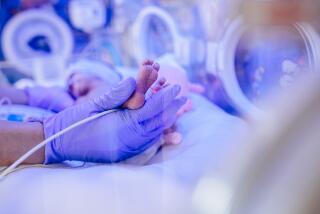Device identifies babies in distress
Thousands of infants sustain brain damage each year because theyâre deprived of oxygen during delivery.
Although fetal monitors are used to detect problems during labor, their readings can be ambiguous. Consequently, knowing when to intervene is difficult. If doctors wait too long, the newborn can be permanently injured; intervening prematurely can result in an unnecessary surgery.
However, an innovative fetal monitoring device may better identify babies in trouble, potentially reducing the incidence of brain injury and the number of unwarranted caesareans.
âHopefully, this will be a more accurate and reliable tool than what we have now to diagnose fetal distress,â says Dr. Dev Maulik, a professor of obstetrics and gynecology at the State University of New York, Stony Brook, who is involved in tests of the monitor. About 8,000 of the 4 million children born in the U.S. every year sustain brain damage because their blood flow or oxygen supply is cut off during labor or delivery. The results include cerebral palsy, mental retardation, learning disabilities and seizures.
To help prevent these injuries, fetal heart-rate monitoring is routine during labor. Such monitoring is done either externally, with a hand-held ultrasound probe on the motherâs abdomen, or by placing an electrode on the babyâs head via the vagina to count the fetal heart rate during contractions.
But changes in overall fetal heart-rate patterns can be misleading. In half the cases, babies with an abnormal heart rate are in no immediate danger; in other instances, babies with normal heart rates can be in serious trouble.
âItâs a pretty big leap from seeing these patterns to knowing for sure that oxygen delivery to the babyâs brain is impaired,â says Dr. Lawrence D. Devoe, chairman of the department of obstetrics and gynecology at the Medical College of Georgia in Augusta.
A doctorâs options at that point are to continue watching the baby to see if the pattern gets worse, or to do an immediate delivery, which isnât necessary in half of the cases and contributes to the nationâs unflaggingly high 26% C-section rate.
The experimental device, called the STAN S21 Fetal Heart Monitor system, gives physicians more precise information. Using an electrode attached to the babyâs head, the device tracks the heartbeatâs ST segment, which is an electrical impulse that can be measured by an electrocardiogram.
Elevations in the ST segment indicate that not enough oxygen is getting to the heart and âthe babyâs defenses are crumbling,â says Devoe, who is among doctors testing the device. The ST segment, which is also measured during treadmill stress tests, shows how well the heart muscle is handling stress -- in this case the stress of going through the contractions of birthing.
Previous human trials, says Maulik, âshowed a definite benefit.â
In two studies of about 8,000 births in England and Sweden in the late 1990s, use of the monitor resulted in a 50% reduction in babies born at greater risk for neurological problems. None of them suffered any brain damage, and C-section rates were cut by 20%.
The monitor, which is already used in Europe, is being studied in 700 to 750 deliveries at six sites in the U.S. The test should be completed within the next several weeks, and researchers hope the device will be available here by 2006.
âThis system adds another piece of key information,â says Devoe, âand will help doctors do the right thing at the right time without elevating C-section rates.â
*
(BEGIN TEXT OF INFOBOX)
Another way to monitor hearts
A similar fetal heart monitor has been devised by University of Florida physicians working with an engineering firm, but itâs not as far along in development.
The monitor measures the ST segment with sensors on the motherâs abdomen. âWeâre trying to get the same information but without the risks of placing electrodes on the babyâs head,â says co-inventor Dr. Tammy Euliano, chief of obstetric anesthesiology at the University of Florida College of Medicine in Gainesville. The device has been tested in 250 births. âWeâre still refining the technology,â says Euliano, who hopes to have a product on the market within five years.





